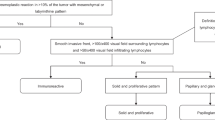Abstract
Objective
To document the experience regarding patients treated for endometrial clear cell carcinoma (ECCC), with reference to clinical, biochemical, histopathologic, and prognostic features.
Material and methods
Twenty-six ECCC patients, diagnosed and treated between 2008 and 2014, were reviewed retrospectively. From the hospital records, all data related to patients’ demographic, clinical, biochemical, and histopathologic assessments and adjuvant therapy adjustments were evaluated. Disease-free survival (DFS), overall survival (OS), and 5-year cumulative survival rates (CSR) were estimated as well as prognostic factors associated with OS.
Results
The median follow-up time was 22.7 months, and the mean age at diagnosis was 64.0 years. Fourteen (53.8 %) women had early stage and 12 (46.2 %) women had advanced-stage disease. There were 17 (65.3 %) patients with pure clear cell carcinoma and 8 (30.7 %) patients with mixed histology on the hysterectomy specimen. Extra-uterine disease occurred more frequently in patients with pure ECCC and elevated CA-125 concentrations. Seventeen (65.3 %) patients received adjuvant platinum and taxane chemotherapy with (n: 13/17, 76.4 %) or without radiotherapy in the form of external beam radiotherapy (ERT) and/or vaginal brachytherapy (BRT). The rest of the patients (n: 9/26, 34.6 %), who had tumor with no or limited myometrial invasion without LVSI, impaired general health status, and non-compliance-to-post-operative treatment proposal received no adjuvant therapy. The mean DFS and OS were 49.54 and 50.01 months, respectively, with the 5-year CSR of 46.4 %. The mean OS was significantly shorter in patients with higher pre-operative CA-125 values, >2 cm tumor diameter, myometrial invasion ≥1/2, cervical involvement, uterine serosal and/or adnexal invasion, lymph node metastasis, and, thus, with advanced-stage disease. Uterine serosal invasion was the only significant prognostic factor associated with OS in the multivariate analysis.
Conclusion
Increased pre-operative serum CA-125 levels are associated with advanced-stage disease, and uterine serosal involvement is a significant prognostic factor associated with OS in women with ECCC.


Similar content being viewed by others
References
Brassard L, Bessette P (2012) Value of gynecological cytology and CA 125 level for the prediction of extrauterine malignancy in endometrial cancer. J Obstet Gynaecol Can 34(7):657–663
Chang-Halpenny CN, Natarajan S, Hwang-Graziano J (2013) Early stage papillary serous or clear cell carcinoma confined to or involving an endometrial polyp: outcomes with and without adjuvant therapy. Gynecol Oncol 131(3):598–603
Greggi S, Mangili G, Scaffa C, Scala F, Losito S, Iodice F, Pisano C, Montoli S, Vigano R, Pirozzi G, Giannarelli D (2011) Uterine papillary serous, clear cell, and poorly differentiated endometrioid carcinomas: a comparative study. Int J Gynecol Cancer 21(4):661–667
Hasegawa K, Nagao S, Yasuda M, Millan D, Viswanathan AN, Glasspool RM, Devouassoux-Shisheboran M, Covens A, Lorusso D, Kurzeder C, Kim JW, Gladieff L, Bryce J, Friedlander M, Fujiwara K (2014) Gynecologic Cancer InterGroup (GCIG) consensus review for clear cell carcinoma of the uterine corpus and cervix. Int J Gynecol Cancer 24(9 Suppl 3):S90–S95
Hsu KF, Chou HH, Huang CY, Fu HC, Chiang AJ, Tsai HW, Chen JR, Cheng WF, Ke YM, Chang CC, Chen TH, Lin SH, Ho CM (2014) Prognostic factors and treatment outcomes for patients with surgically staged uterine clear cell carcinoma focusing on the early stage: a Taiwanese Gynecologic Oncology Group study. Gynecol Oncol 134(3):516–522
Köse MF, Meydanlı MM, Boran N, Tulunay G, Kayıkçıoğlu F, Özgül N, Ceyhan K (2000) Clear cell carcinoma of the endometrium: the impact of surgical staging. Gynecol Obstet Reprod Med 6:132–136
Laufer J, Scasso S, Papadia A, Sosa C, Cirillo F, Raspagliesi F (2013) Association between tumor diameter and lymphovascular space invasion among women with early-stage endometrial cancer. Int J Gynaecol Obstet 123(2):142–145
Ly D, Rowley BD, Dodson MK, Soisson PA, Jolles CJ, Gaffney DK, Sause WT (2014) Adjuvant radiation in early stage, unfavorable histology endometrial carcinoma is associated with improved local control and survival. Gynecol Oncol 133(2):250–255
Mattes MD, Lee JC, Metzger DJ, Ashamalla H, Katsoulakis E (2015) The incidence of pelvic and para-aortic lymph node metastasis in uterine papillary serous and clear cell carcinoma according to the SEER registry. J Gynecol Oncol 26(1):19–24
Roelofsen T, Mingels M, Hendriks JC, Samlal RA, Snijders MP, Aalders AL, Bulten J, van Ham MA, Massuger LF (2012) Preoperative CA-125 predicts extra-uterine disease and survival in uterine papillary serous carcinoma patients. Int J Biol Mark 27(3):e263–e271
Scarfone G, Secomandi R, Parazzini F, Vigano R, Mangili G, Frigerio L, Villa A, Tateo S, Ricci E, Bolis G (2013) Clear cell and papillary serous endometrial carcinomas: survival in a series of 128 cases. Arch Gynecol Obstet 287(2):351–356
Townamchai K, Berkowitz R, Bhagwat M, Damato AL, Friesen S, Lee LJ, Matulonis U, O’Farrell D, Viswanathan AN (2013) Vaginal brachytherapy for early stage uterine papillary serous and clear cell endometrial cancer. Gynecol Oncol 129(1):18–21
Xu Y, Hanna RK, Elshaikh MA (2016) Adjuvant therapy of uterine clear cell carcinoma: a review. Arch Gynecol Obstet 293(3):485–492
Yildiz A, Yetimalar H, Kasap B, Aydin C, Tatar S, Soylu F, Yildiz FS (2012) Preoperative serum CA 125 level in the prediction of the stage of disease in endometrial carcinoma. Eur J Obstet Gynecol Reprod Biol 164(2):191–195
Acknowledgments
We thank Dr. Anita L. Akkas (PhD in English Literature) for contributing to the English editing.
Author information
Authors and Affiliations
Corresponding author
Ethics declarations
The present study was approved by the Institutional Review Board of Zekai Tahir Burak Women’s Health Education and Research Hospital.
Conflict of interest
There is no conflict of interest, and the authors hereby declare that they have no competing financial interests.
Additional information
This study was carried out in the Department of Gynecologic Oncology, Zekai Tahir Burak Women’s Health Education and Research Hospital, Ankara, Turkey.
Rights and permissions
About this article
Cite this article
Cetinkaya, N., Selcuk, İ., Ozdal, B. et al. Prognostic factors in endometrial clear cell carcinoma. Arch Gynecol Obstet 295, 189–195 (2017). https://doi.org/10.1007/s00404-016-4183-x
Received:
Accepted:
Published:
Issue Date:
DOI: https://doi.org/10.1007/s00404-016-4183-x




